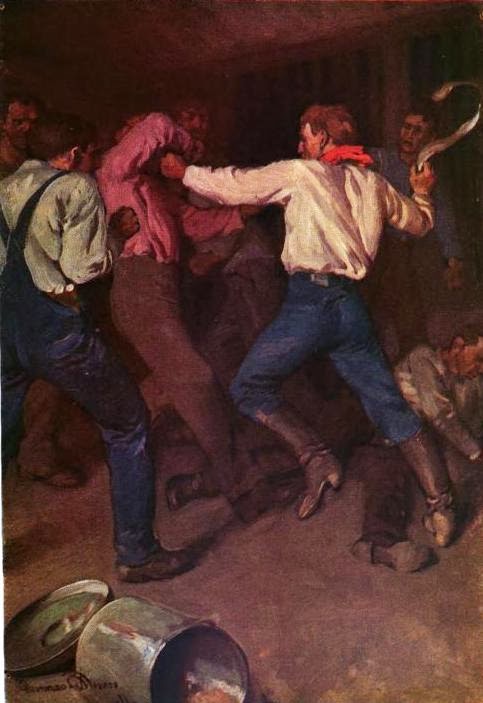Plot and character.
Crittendon hires Pecos to alter the brands on any of Upton’s cattle he finds on
the range. Meanwhile, the local sheriff, Boone Morgan, is alert to any signs of
cattle theft, and when Crittendon falsely accuses Pecos of stealing a cow, he
gets hauled in to the county jail, to await trial.
 |
| Pecos draws his pistol |
Pecos, as Dane Coolidge describes him, was “born a Democrat and
taught to love whiskey and hate Mexicans.” However, he has begun reading an
anti-capitalist newspaper, The Voice of Reason, which has opened his eyes to the corrupt law enforcement system used
by the rich to oppress the poor. Sheriff Morgan soon learns he has incarcerated
an outspoken advocate of revolution.
Cracking heads, Pecos immediately overturns Morgan’s use
of a prisoner-run kangaroo court for maintaining order in the jail. Joined by a
friend and fellow revolutionary, Angevine “Babe” Thorne (jailed for drunk and disorderly),
and winning the respect and protection of the Mexican prisoners, Pecos takes
charge behind bars. He is soon getting preferred treatment from Hung Wo,
provider of the jail’s meal service.
A crisis quickly looms with the rising stench of undisposed
waste in the cells, now that the Mexicans, observing their new status as
equals, have stopped cleaning up after the white inmates. Pecos orders them all
to do their own clean up but is discouraged by their defiant attitude. His
dedication to revolution and his commitment to fight “the crime of government”
are put to the test by “the low and churlish spirit of the masses.” Soon he is
cracking heads again and holding kangaroo courts of his own.
 |
| Pecos takes charge |
At first rightly distrustful of the press, as a willing mouthpiece
for the powers that be, Pecos finds a local reporter happy to compromise his
loyalties to gain the ear of the public with a good story. Before long, Pecos
is managing his own public image in the newspaper.
When his own trial date finally approaches, Pecos enlists
Thorne, a fiery orator, to defend him against the county’s district attorney,
Shepherd Kilkenny, who has a long record of convictions, largely through
cunning and intimidating plea bargains. Pecos doesn’t yield, however. And by
allowing the jury to be stacked with cattlemen, Thorne adroitly persuades them
that acquittal is in their own best interest.
It also helps that a witness comes forward with evidence
that the cow alleged by Crittendon to be stolen from him belonged in fact to
Pecos. Crittendon’s sworn testimony is thus revealed as perjury, and he is
packed off to jail, where Pecos encourages the inmates to give the man what he
deserves for his treachery.
 |
| Marcelina visits the prisoner |
Romance.
Marcelina, the daughter of one of Crittendon’s Mexican employees, catches the
eye of Pecos early on, and he courts her with gifts from a mail order catalog.
Her heart totally stolen away by the handsome young cowboy, she remains true to
him, even as her protective mother sends her off to a convent school. Knowing
him to be innocent of cattle theft, Marcelina is the one who testifies in his
defense at his trial.
A free man again, and given proceeds in the amount of
$1,000 for sale of his herd of cattle taken in payment for unpaid taxes, Pecos
is able to offer marriage with her parents’ consent. No longer a broke drifting
cowboy, someone tells him, there’s nothing to keep him from becoming a
capitalist cowman.
Maynard Dixon. A
great treat for readers of westerns and frontier fiction from the turn of the
last century is the contribution of many first-rate illustrators. One of these
was San Francisco artist Maynard Dixon (1875-1946), whose illustrations
typically heighten the drama at key points of the text. I have included as many of his from The Texican as I can crowd onto this page.
 |
| Pecos's cow and calf |
Wrapping up. The
Texican was Coolidge’s second
published novel, the first being Hidden Water (1910) an account of a peaceable cowman up against a
couple of villainous sheep men. Very different in tone, The Texican is marked by humor and irony, especially in its
portrayal of political theory vs. reality. It was a time of economic disparity,
when socialist thought and Theodore Roosevelt-style progressivism found
adherents among western writers. With The Texican, Coolidge participates in that public discourse, but
largely with tongue in cheek.
Hidden Water and The Texican were the first of over 50 western novels by
Dane Coolidge (1873-1940). Over three decades he also published countless short
stories, appearing in Street & Smith’s The
Popular Magazine, Western Story Magazine,
and many others.
The Texican is
currently available at google books and for kindle and the nook. For more of
Friday’s Forgotten Books, click on over to Patti Abbott’s blog.
Further reading:
BITS reviews of novels by Dane Coolidge
Coming up: Glossary
of frontier fiction

I thought I'd seen that frontispiece painting somewhere before. I checked, and sure enough I had—it's by Maynard Dixon and was titled "The Puzzled Cowboy" where I saw it. I've been surprised sometimes how many earlier Western paintings turn out to be illustrations from books!
ReplyDeleteI would probably enjoy an older satire better than a newer one.
ReplyDeleteGreat novel, great illustrations, great review. What has happened to the western field?
ReplyDelete